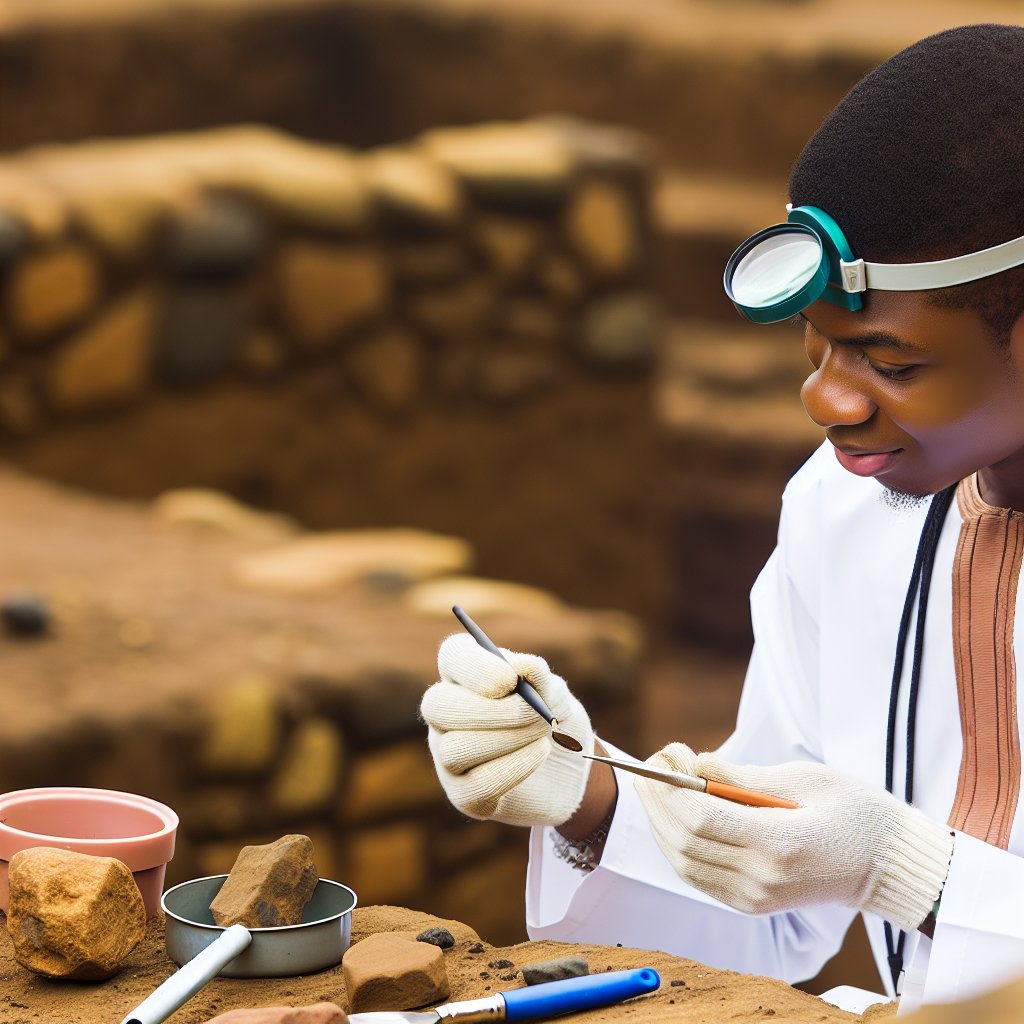Introduction
Archaeology in Nigeria involves the study of past human activities through material remains.
Definition of archaeology
Archaeology is the scientific study of human history and prehistory through excavation and analysis.
Importance of archaeology in Nigeria
Archaeology in Nigeria helps to understand the evolution of human societies, culture, and technology.
It also preserves the country’s heritage.
Tools Used in Nigerian Archaeology
When it comes to excavating archaeological sites in Nigeria, there are several tools and techniques that archaeologists rely on to uncover and document the country’s rich history.
From basic tools like trowels and shovels to more advanced equipment like GPS devices, each tool plays a crucial role in the archaeological process.
Trowel
The trowel is perhaps the most essential tool in an archaeologist’s kit.
It is used for delicate excavation work, allowing archaeologists to carefully uncover artifacts and structures without causing damage.
Trowels come in various sizes and shapes, depending on the specific task at hand.
Shovel
Shovels are used for larger-scale excavation work, such as removing topsoil or digging trenches.
Archaeologists use shovels to quickly move earth and debris while excavating a site.
Shovels are also essential for clearing vegetation and debris from the surface of an archaeological site.
Brush
Brushes are another important tool in Nigerian archaeology.
Archaeologists use brushes to gently remove dirt and debris from artifacts and structures.
Brushes are particularly useful for cleaning fragile objects or intricate details that may be obscured by dirt.
Sieve
Archaeologists use sieves to sift through soil and sediment removed from an excavation site.
This process helps archaeologists find smaller artifacts or ecofacts that may be missed during excavation.
Sieves are especially useful for separating artifacts from the surrounding soil.
GPS Device
GPS devices are crucial for accurately mapping and recording the location of excavation sites in Nigeria.
Archaeologists use GPS devices to create detailed maps of sites, document the exact coordinates of artifacts, and track the progress of excavations.
GPS technology has revolutionized the way archaeologists record and analyze archaeological data.
Techniques used in Nigerian archaeology
Archaeologists in Nigeria use various techniques to uncover, analyze, and preserve artifacts and sites that provide insights into the country’s rich history.
Some of the key techniques used in Nigerian archaeology include excavation, survey, analysis, dating methods, and preservation.
Excavation
- Excavation is a fundamental technique used by archaeologists in Nigeria to unearth artifacts and structures buried beneath the ground.
- Archaeologists carefully dig into the soil layer by layer, recording the location and orientation of artifacts and features they encounter.
- Excavation allows archaeologists to uncover a site’s stratigraphy, which helps in understanding the chronological sequence of events at the site.
Survey
- Survey involves systematically walking across a landscape to identify potential archaeological sites based on surface artifacts and features.
- Archaeologists use various survey techniques such as pedestrian survey, remote sensing, and Geographic Information Systems (GIS) mapping.
- Survey helps archaeologists locate sites, understand their distribution patterns, and prioritize areas for further investigation through excavation.
Analysis
- Analysis is a crucial step in Nigerian archaeology, where artifacts and data collected during excavation and survey are studied in detail.
- Archaeologists analyze artifacts for their cultural significance, material composition, provenance, and relationship to other finds.
- Analysis also includes environmental and spatial analysis to reconstruct past landscapes and understand the interactions between humans and their environment.
Dating methods
- Dating methods are used to determine the age of artifacts, features, and sites in Nigerian archaeology.
- Archaeologists use absolute dating methods such as radiocarbon dating, luminescence dating, and dendrochronology.
- Relative dating methods like stratigraphy and seriation are also employed to establish the sequence of events at a site.
Preservation
- Preservation is essential in Nigerian archaeology to protect and conserve artifacts, sites, and cultural heritage for future generations.
- Archaeologists employ various preservation techniques such as stabilizing fragile artifacts, creating conservation plans, and implementing site management strategies.
- Preservation also involves community engagement, education, and advocacy to raise awareness about the significance of archaeological heritage.
You Might Also Like: Success Stories: Nigerian Applied Biology Alumni
Challenges faced in Nigerian archaeology:
- Limited funding
- Lack of skilled personnel
- Illegal excavation and looting
- Inadequate infrastructure
- Lack of public awareness
Despite the importance of preserving Nigeria’s cultural heritage, archaeology often receives minimal financial support.
There is a shortage of trained archaeologists and experts in various specialized fields within Nigerian archaeology.
The rampant looting of archaeological sites for artifacts and underground treasures poses a significant threat to Nigeria’s heritage.
Many archaeological sites in Nigeria lack proper facilities, such as museums, storage areas, and laboratories, for preservation and research.
There is a general lack of public interest and awareness regarding the importance of archaeology in Nigeria’s history and culture.
Addressing these challenges requires a collaborative effort involving government support, educational institutions, and community engagement to protect and promote Nigeria’s rich archaeological heritage.
Find Out More: Professional Bodies for Applied Mathematicians in Nigeria
Recent Developments in Nigerian Archaeology
In recent years, Nigerian archaeology has seen significant advancements in technology and methodology.
Digital Mapping
One of the tools that have revolutionized Nigerian archaeology is digital mapping.
This technology allows archaeologists to create accurate maps of excavation sites.
It provides valuable insights into the layout and structures of ancient civilizations.
Geophysical Surveys
Geophysical surveys have also become a popular technique in Nigerian archaeology.
By using ground-penetrating radar and other geophysical equipment, archaeologists can uncover buried structures.
This technique allows them to explore without disturbing the site.
Collaborations with International Institutions
Another important development in Nigerian archaeology is the increase in collaborations with international institutions.
These partnerships allow for the exchange of knowledge, resources, and technology.
Transform Your Career with Expert Guidance
Get personalized mentorship consulting that’s tailored to your unique path. Our expert advice is actionable and exclusive.
Get StartedSuch collaborations enhance the quality and scope of archaeological research in Nigeria.
Use of Drones for Aerial Surveys
Drones have become an essential tool for conducting aerial surveys in Nigerian archaeology.
These unmanned aerial vehicles can capture high-resolution images of excavation sites.
Moreover, they provide archaeologists with valuable data for analysis.
By incorporating these tools and techniques into their research, Nigerian archaeologists are able to uncover new discoveries.
They gain a deeper understanding of the country’s rich archaeological heritage.
These advancements have the potential to transform the field of Nigerian archaeology.
They also shed light on the ancient civilizations that once thrived in the region.
You Might Also Like: Research Opportunities in Nigerian Applied Chemistry

Case studies in Nigerian archaeology
Nigeria is rich in archaeological sites that provide valuable insights into the country’s cultural and historical heritage.
Several case studies have been conducted to study these sites and understand more about Nigeria’s past.
Nok terracotta sculptures
The Nok terracotta sculptures are one of the earliest examples of clay sculptures in sub-Saharan Africa.
These sculptures date back to around 500 BC to 200 AD and were discovered in Nok, in present-day Nigeria.
Archaeologists have studied these sculptures to learn about the artistic and cultural practices of the ancient Nok people.
The intricate designs and details on the sculptures provide clues about the society’s beliefs, traditions, and daily life.
Igbo-Ukwu archaeological site
The Igbo-Ukwu archaeological site is another important case study in Nigerian archaeology.
It is located in southeastern Nigeria and dates back to the 9th century AD.
Excavations at the site have revealed a wealth of artifacts, including bronze objects, jewelry, and pottery.
These artifacts showcase the advanced metalworking and artistic skills of the ancient inhabitants of Igbo-Ukwu.
Sungbo’s Eredo earthworks
Sungbo’s Eredo is a series of earthworks located in southwestern Nigeria.
The earthworks are believed to have been constructed in the 11th century AD and served as a defensive system for the town of Ijebu-Ode.
Archaeological studies of Sungbo’s Eredo have provided insights into the political and social organization of the ancient Yoruba people.
The earthworks are a testament to the ingenuity and engineering capabilities of the people who built them.
Benin City walls
The Benin City walls are a series of defensive fortifications surrounding the ancient city of Benin in present-day Nigeria.
The walls were constructed in the 13th century AD and are one of the longest ancient earthworks in the world.
Archaeological research on the Benin City walls has shed light on the military strategies and urban planning of the Benin Kingdom.
The walls are a remarkable example of the engineering prowess of the Benin people.
Gashaka Gumti National Park rock paintings
Gashaka Gumti National Park is home to rock paintings that date back thousands of years.
These paintings provide a glimpse into the artistic expression of the ancient peoples who inhabited the region.
Archaeologists have studied these rock paintings to understand the cultural beliefs, rituals, and daily life of the prehistoric inhabitants of Nigeria.
The paintings are a valuable record of Nigeria’s early artistic traditions.
The tools and techniques used in Nigerian archaeology have helped researchers uncover the rich history and heritage of the country.
Through case studies like the Nok terracotta sculptures, Igbo-Ukwu archaeological site, Sungbo’s Eredo earthworks, Benin City walls, and Gashaka Gumti National Park rock paintings, archaeologists have been able to piece together the puzzle of Nigeria’s past.
These case studies provide valuable insights into the artistic, cultural, and technological achievements of Nigeria’s ancient peoples and contribute to our understanding of the country’s diverse history.
See Related Content: Environmental Impact of Mining in Nigeria
Summary of tools and techniques used in Nigerian archaeology
In Nigerian archaeology, tools such as trowels, brushes, sieves, and cameras are used for excavation and documentation.
Techniques like stratigraphy, radiocarbon dating, and ground-penetrating radar are employed to analyze artifacts and sites.
Importance of preserving Nigeria’s cultural heritage through archaeology
Preserving Nigeria’s cultural heritage through archaeology helps in understanding the country’s rich history and diverse cultures.
It contributes to national identity, heritage tourism, and education, fostering a sense of pride and respect for cultural legacy.
Future prospects for Nigerian archaeology
The future of Nigerian archaeology looks promising with advancements in technology and increasing interest in cultural preservation.
Collaborations with international archaeologists, research funding, and public awareness campaigns will further enhance the field.
Nigerian archaeology’s significance in cultural preservation
Nigerian archaeology plays a crucial role in uncovering the past, preserving heritage, and shaping the future of the nation.
By utilizing tools and techniques effectively, Nigeria can continue to explore its archaeological landscape and strengthen its cultural legacy.
Additional Resources
Edo|cation: Researching and Preserving the Cultural Heritage … – DAI
Nigeria’s Archaeological Heritage: Resource Exploitation and …




